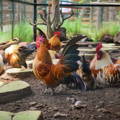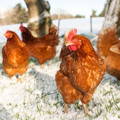
Subscribe
To join our mailing list and never miss an update!
Bumblefoot, also known as pododermatitis, is a bacterial infection condition that affects the feet of birds, including poultry and pet birds. It is characterized by inflammation and swelling of the footpad, often accompanied by the formation of a painful lesion or abscess. Bumblefoot is more common in birds that spend a significant amount of time on hard surfaces, such as wire cages or rough flooring.

The condition can be caused by various factors, including bacterial infections, injuries, poor nutrition, and unsanitary living conditions. Bumblefoot is often seen in birds like chickens, ducks, and other domesticated fowl, but it can also occur in pet birds like parrots.
BUMBLEFOOT PREVENTION
Preventing bumblefoot involves providing birds with a clean and comfortable living environment, using appropriate bedding and substrate, and providing a well-balanced diet. Regular inspection of the feet for any signs of swelling, redness, or lesions is essential for early detection and treatment.
1. Clean and Dry Living Conditions
Ensure that the chicken coop is clean and dry. Moist and dirty conditions can contribute to the development of bacterial infections. If you use bedding material on your coop floor, choose straw or wood shavings, to provide a soft and absorbent surface. However, be sure to change it frequently. While these materials offer an easier landing for your chicken’s feet, they are also breeding grounds for bacteria and disease.
The same principle applies to your chicken yard or run. Sand is an excellent choice that provides good drainage and does not cut or scratch the bottom of your chicken’s feet. Avoid landscape materials that have sharp edges and no shock absorbing qualities like decorative garden pebbles or river rocks.

2. Proper Flooring
Avoid wire flooring in cages, as it can cause pressure sores on the feet. If using wire flooring is unavoidable, provide areas with solid surfaces for the chicken to rest.
Provide perches of various diameters and textures to promote healthy foot muscles and prevent constant pressure on one part of the foot.
3. Regular Inspection
Inspect the chicken's feet regularly for any signs of swelling, redness, or lesions. Early detection allows for prompt treatment and reduces the risk of complications.
Gently pick up and examine each foot, paying attention to the footpads and between the toes. Look for swelling, lesions, cuts and scabs on the bottom of the foot pads.
4. Proper Nutrition
Feeding a well-balanced and nutritious diet to ensure the overall health of your flock increases their ability to resist infections. Provide access to clean water at all times.

5. Maintain Healthy Weight
Avoid obesity in chickens, as excess weight can put additional stress on their feet. Ensure they have enough space to move and exercise.
Particular breeds and hybrid chicken breeds are more prone to bumblefoot simply because of their heavier body weight. These include brahmas, gold sexlings and any hybrid bred meat birds that are designed to grow fast and put on weight to reach market for food consumption.
6. Handle Poultry Carefully
Handle birds gently and set them on the ground to avoid foot cuts and injuries. Releasing a chicken from waist height causes them to land hard on their feet and increases the likelihood of a cut on the bottom of their feet.
By implementing these preventive measures, you can significantly reduce the risk of bumblefoot in your flock and promote their overall wellbeing.
Non-Invasive Treatment of Mild Bumblefoot

Trending Articles


Surgical Removal of Bumblefoot
In severe cases, surgical intervention may be necessary to remove abscesses and promote healing. The removal of the bumblefoot corn can be done at home successfully by the chicken keeper and it a relatively easy procedure.
Here's an overview of the general steps involved in the surgical removal of bumblefoot after thoroughly sterilizing the affected are of the chicken foot.

In essence, safeguarding birds from bumblefoot entails maintaining clean living spaces, ensuring a balanced diet, and handling them gently. Early detection and intervention are key, with non-invasive treatments like isolation and warm soaks for mild cases, and surgical removal for severe cases. By adopting these practices, bird keepers can enhance the overall health and happiness of their avian companions.
Trending Products
Copyright©2024 All rights reserved. We love to have you share our article as long as you include a direct link to this page. This article or any portion thereof , including all images, may not be reproduced or used in any manner whatsoever without the express written permission of Gypsy Shoals Farm.



